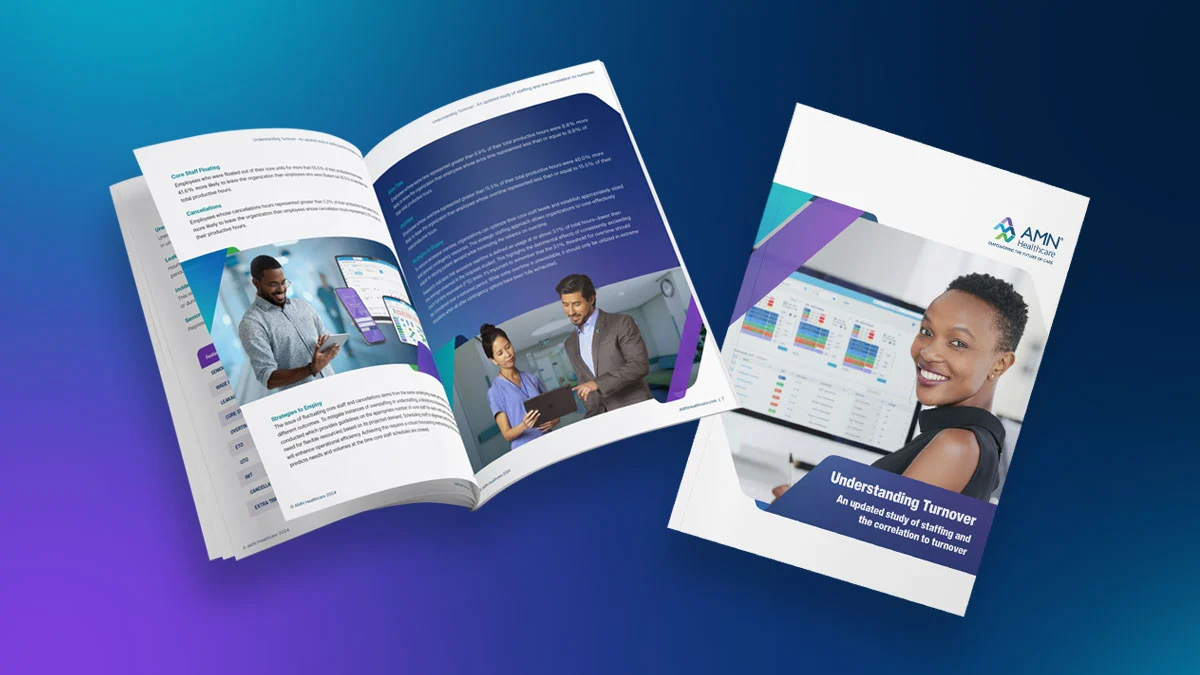
The Rise of AI in Healthcare Staffing and Scheduling
Algorithms and machine learning are embedded into almost everything these days. Everywhere you turn, there’s talk of artificial intelligence (AI) and machine learning to crunch numbers and analyze data patterns to improve efficiencies and provide more a meaningful client and customer experience.
Staff scheduling in healthcare? Yes, there are algorithms for that, too.
More and more healthcare organizations are turning to algorithms and machine learning to improve workforce operations. They are designed to control labor costs by calculating exactly how many healthcare workers are needed at the unit and enterprise level in the future. Accurate schedules created well in advance of a shift can have a tremendous impact on the professional and personal lives of healthcare workers.
By contrast, unpredictable and overburdened schedules can take a toll on almost everybody working in healthcare. It’s no wonder that burnout has become an official medical diagnosis according by the World Health Organization (WHO). With healthcare organizations seeking to improve patient experience while increasing efficiency and cutting costs, many are turning to vendor partners that provide predictive labor analytics and related solutions incorporating algorithms and machine learning technology.
Fair and Consistent Scheduling
Healthcare workers appreciate a consistent and fair schedule that they can rely on. But it’s often elusive, and that impacts everything from the personal lives of clinicians to patient satisfaction and outcomes. Trying to schedule staff in a fair and productive way can be very frustrating for managers. Without the proper tools, it can be almost impossible, depending on the size and complexity of the organization.
This is where machine learning and automation can be most effective. If there is a task that can be automated, AI can deliver, and it can typically deliver more accurately and efficiently than a human. This does not in any way denigrate the human touch in healthcare management. Quite the contrary, it improves the personal and professional experience.
Working in the volatile environment of patient care exacts an emotional and physical toll on healthcare professionals. On top of that, the stressors of schedule issues, perceived difficulties in taking a vacation, conflicts with managers and other co-workers — all of this can leave nurses and other professionals burned out, sometimes within a few years of beginning their career.
Healthcare organizations that use predictive analytics for nurse scheduling and staffing have achieved outcomes that include increased staff satisfaction scores and improved nurse retention, while decreasing the amount of time managers spend on schedule creation and staffing tasks.
Automation not only means increased efficiencies for an organization, but it can also ease a lot of strain on workers. Building accurate schedules that optimize the available workforce provides workers with a healthy and consistent schedule that isn’t going to burn them out.
AI Doesn’t Replace People
Far from replacing human decision-making and vital interpersonal relationships in the workplace, artificial intelligence provides advanced technology-enabled solutions that enhance human decisions. Along with accurate forecasting, good schedule oversight is necessary for appropriate staffing and to mitigate any potential problems. Ensuring staff commitments are met, submitting schedules on time, making sure there is a competency mix of resources (charge nurses, experienced RNs, travel nurses), and utilizing contingency resources such as float pools are steps to take to ensure a properly balanced schedule. And these are tasks that must be done by the person in charge of scheduling.

Predictive analytics technology is not magic, and it doesn’t replace people in the healthcare workplace. You can’t plug it in, press a button, and expect perfection. Nurse scheduling software that is fueled by predictive analytics is only as good as the data it is fed and the people who use it. And it’s also only as good as the predictive analytics partner, and its expertise in technology-enabled solutions for the healthcare workforce.
In the end, artificial intelligence is a tool. It can be an incredibly effective tool – or not – in the advancement of healthcare staffing and solutions. It all depends on the people wielding the tool.
For more information, read the Predictive Analytics in Healthcare Staffing Survey: https://www.amnhealthcare.com/2016-Predictive-Analytics-Survey/
Latest News
Reducing the Need for Contingent Labor by Leveraging Technology: Geisinger's Playbook for Transforming the Workforce
Learn how top systems like Geisinger reduced their reliance on contingent labor by embracing new technology, advanced analytics and real-time workforce tools.
Webinar: Understanding Turnover: Data-Driven Strategies for Healthcare Staffing Stability
Discover how healthcare leaders are overcoming workforce hurdles in this recorded webinar featuring experts from AMN Healthcare and Renown Health.
Scheduling for Maximum Efficiency: A Comparison of 4, 6, and 8-Week Schedule Periods
Optimizing workforce management is crucial for delivering high-quality patient care while
Enhanced Workforce Planning with Real-Time Insights
Workforce planning is a balancing act—juggling operational demands, financial targets, and the need for actionable insights.
Smart Square Named 2025 Best in KLAS for Nurse and Staff Scheduling
AMN Healthcare, the leader and innovator in total talent solutions for healthcare organizations, has been recognized with the 2025 Best in KLAS Scheduling: Nurse & Staff award for its industry
Understanding Turnover: A Study of Staffing and the Correlation to Turnover
By focusing on key staffing metrics like cancellations, overtime, and core staff floating, you can uncover actionable insights to transform your workforce strategy and retain top talent.
Revolutionize Your Locums Staffing with ShiftWise Flex
ShiftWise Flex is a cloud-based Vendor Management System (VMS) that offers comprehensive capabilities to manage healthcare professionals, including physicians, nurses, and allied health workers,
Optimize Staffing with Smart Square's Data-Driven Insights
Unlock the power of data with Smart Square's advanced reporting abilities. Making informed decisions is key to optimizing staffing and improving overall efficiency










